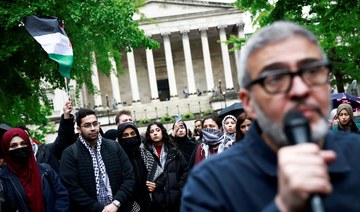ROUEN: FranceŌĆÖs Interior Minister said Friday that a man who was shot and killed by police after a suspected arson attack on a synagogue in the Normandy city of Rouen was an Algerian national whoŌĆÖd sought medical treatment in France and wasnŌĆÖt flagged as a suspected extremist.
The minister, Gerald Darmanin, praised the 25-year-old police officer who shot and killed the man, saying he will be decorated for his ŌĆ£extremely courageous, extremely professionalŌĆØ behavior faced with the suspected attacker who rushed at him with a kitchen knife early Friday after the blaze broke out at the synagogue.
Fire services were alerted early Friday morning to a blaze at the synagogue. Police officers who deployed discovered the man on the roof of the building, clutching the metal bar in one hand and the kitchen knife in the other, and smoke rising from the synagogueŌĆÖs windows, Rouen prosecutor Fr├®d├®ric Teillet said at a brief news conference.
He said the man hurled abuse and threw the metal bar at the police before jumping off the roof and then running at one of the officers with his knife raised.
The officer fired five shots, hitting the man four times, fatally wounding him, the prosecutor said. He said authorities are seeking to verify the manŌĆÖs identity. The prosecutor took no questions.
Interior Minister Gerald Darmanin posted on the social media site X that the man was ŌĆ£clearly wanting to set fire to the cityŌĆÖs synagogue.ŌĆØ
He congratulated officers for ŌĆ£their reactivity and their courage.ŌĆØ
Tensions and anger have grown in France over the Israel-Hamas war. Antisemitic acts have surged in the country, which has the largest Jewish and Muslim populations in western Europe.
Rouen Mayor Nicolas Mayer-Rossignol said the man is thought to have climbed onto a trash container and thrown ŌĆ£a sort of Molotov cocktailŌĆØ inside the synagogue, starting a fire and causing ŌĆ£significant damage.ŌĆØ
ŌĆ£When the Jewish community is attacked, itŌĆÖs an attack on the national community, an attack on France, an attack on all French citizens,ŌĆØ he said.
ŌĆ£ItŌĆÖs a fright for the whole nation,ŌĆØ he added.
Photos taken inside the synagogue and seen by The Associated Press showed that walls and the ceiling were charred and blackened.
In Paris, Yonathan Arfi, head of the main French Jewish umbrella group, expressed fury at what he described as the ŌĆ£climate of terrorŌĆØ facing Jews in France. This week, a Paris memorial honoring people who distinguished themselves by helping to rescue Jews in France during the countryŌĆÖs Nazi occupation in World War II was also attacked, defaced with painted blood-red hands.
ŌĆ£ItŌĆÖs unbearable. ItŌĆÖs more and more serious every day. After the antisemitic graffiti we saw in the past few days, antisemitic slogans, antisemitic insults, we now have attempts at setting synagogues on fire,ŌĆØ Arfi, president of the Representative Council of Jewish Institutions in France, told the AP.
ŌĆ£Everyone is wondering whether they can live a peaceful life in France as a Jew,ŌĆØ he added. ŌĆ£ThereŌĆÖs a climate of fear because it feels like, anywhere in our country and at any time, an antisemitic attack can take place. It aims at intimidating French Jews and we wonŌĆÖt accept this intimidation. We refuse it, and we will continue to fight against this unbridled antisemitism.ŌĆØ
French Prime Minister Gabriel Attal said this month that the sharp spike in antisemitic acts in France that followed the Oct. 7 attack by Hamas on Israel has continued into this year.
Authorities registered 366 antisemitic acts in the first three months of 2024, a 300 percent increase over the same period last year, Attal said. More than 1,200 antisemitic acts were reported in the last three months of 2023 ŌĆö which was three times more than in the whole of 2022, he said.
ŌĆ£We are witnessing an explosion of hatred,ŌĆØ he said.























